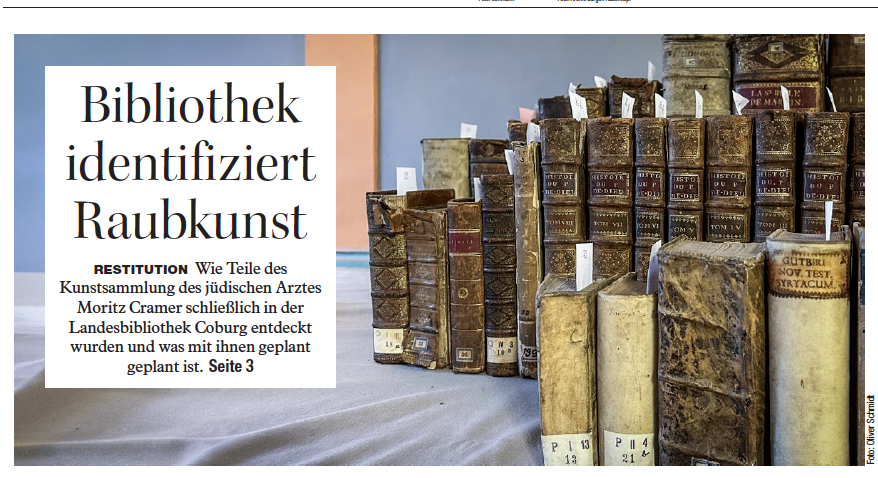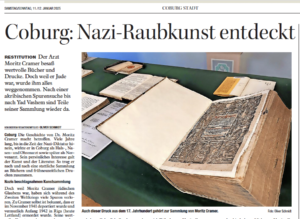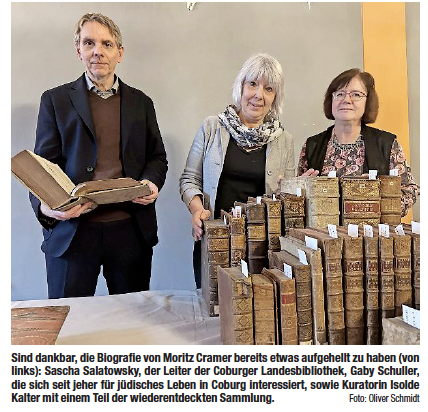 RESTITUTION. How parts of the art collection of the Jewish doctor Moritz Cramer were finally discovered in the Coburg State Library and what is planned for them. (See p. 3)
RESTITUTION. How parts of the art collection of the Jewish doctor Moritz Cramer were finally discovered in the Coburg State Library and what is planned for them. (See p. 3)
*****
 “Coburg: Nazi Loot discovered”
“Coburg: Nazi Loot discovered”
Oliver Schmidt, Coburger Tageblatt, 11/12 January 2025
RESTITUTION The doctor Moritz Cramer owned valuable books and prints, but because he was Jewish, everything was taken away from him
Coburg The story of Dr. Moritz Cramer is moving. For many years, right up to the time of the Nazi dictatorship, he worked in Coburg as an ear, nose and throat specialist and later as a neurologist, with a personal interest in art and literature. He gradually amassed an impressive collection of books and early modern prints.
Nazis confiscate art collection
Because Moritz Cramer was Jewish, many traces of him were lost during the Second World War. It is known that Cramer himself was deported in November 1941 and was probably murdered in Riga (now Latvia) at the beginning of 1942. His valuable art collection was confiscated by the Nazis — what happened to the books and prints afterwards was unknown for more than 80 years. Until now. At least part of the collection has been rediscovered in the Coburg State Library, where the origin of these valuable holdings was previously unknown.
Sascha Salatowsky, the director of the Coburg State Library, spoke about the background to this discovery and how this Nazi-looted art is now being dealt with . In summary: This so-called partial library of Moritz Cramer, which consists of 89 titles in 108 volumes, was initially handed over to a rightful heir. The technical term for this is restitution. The State Library then acquired the Cramer collection and agreed not to disclose the purchase price.
Confidentiality agreement on purchase price
According to Sascha Salatowsky, it is a five-figure sum, but in view of the moving history associated with the partial library, the value can probably not be measured in euros anyway. Gaby Schuller, who has always been interested in Jewish life in Coburg, got the ball rolling. During her research, she came across the little-known biography of Moritz Cramer. He was born in Gleicherwiesen in Thuringia in 1877, attended a humanist grammar school in Hildburghausen and was very interested in languages from a young age, later living in Coburg at Mohrenstraße 9a. His practice was also located there. “He was a respected doctor”, as Gaby Schuller found out.
Discoveries in Yad Vashem.
Even before his deportation in November 1941, the Nazis had confiscated Moritz Cramer’s extensive library and, during her research, Gaby Schuller discovered that most of the books had been destroyed. But the National Socialists did not want to destroy everything, instead handing some of the collection over to a pastor in the Coburg area and to the state library in Coburg at the time. Ironically, Gaby Schuller was only able to find these traces because the Nazis documented everything meticulously and reported the “handovers” to the Coburg tax office. It was precisely these documents that Gaby Schuller came across during her research in Yad Vashem, the Holocaust memorial and documentation center in Jerusalem.
Gaby Schuller’s next step was to contact the current state library in Coburg, which also retains the old holdings of the former state library. Together with its curator, Isolde Kalter, she asked herself the question: Are there any documents in Coburg that could be traced back to the Nazis? Are parts of the library collected by Moritz Cramer now in Ehrenburg Castle, where the Coburg State Library is based? Lists were then compared and holdings checked, books examined and handwritten notes studied. At some point it became clear that yes, a little over one hundred volumes, the provenance of which was still unknown, once belonged to Moritz Cramer.
Contact with Munich
“We then immediately contacted the Directorate General of the Bavarian State Library (BSB),” explains Sascha Salatowsky. After all, it was important to have the handling of the suddenly discovered Nazi-looted art legally clarified. Sascha Salatowsky: “It was decided very quickly to offer restitution to the descendants.”
But where might there be descendants of a childless Moritz Cramer? Once again, Gaby Schuller delved deep into the history of a Jewish family. The result: Moritz Cramer had two brothers. One of them died in the First World War — the other had a son called Hans, who had a daughter in 1947 who later lived in South Africa. In the meantime, this daughter named Melanie had moved to Australia to live with her daughter Sharon, making Sharon the great-grandniece of Moritz Cramer.
Sending books to Australia?
Talks via video link followed, which Gaby Schuller describes as “very moving”. There were also discussions with the BSB (Bavarian State Library) about what to do with the books. “We would have sent them to Australia if that had been the wish of the rightful heir,” says Sascha Salatowsky. But a different solution was found: the heir offered to sell the collection. “The State Library then legally acquired the collection,” says Sascha Salatowsky, who is very grateful that this solution was found. Until now, there has been a great deal of Nazi literature in the holdings, especially from the estate of Duke Carl Eduard, but with the collection of Moritz Cramer, we now also have, for the first time, the library of a Jewish victim of the Nazi dictatorship. “This means we can present both sides of the story,” says Sascha Salatowsky and promises to preserve Moritz Cramer’s legacy. ‘We want to make the collection visible and make it available for research. ’
Where is the second part of the collection?
‘As one of the first steps, all the works are to be given their own label: ’Moritz Cramer Library”. In the medium term, Sascha Salatowsky would like to be able to locate the part of the library that was once handed over to a priest by the Nazis, meaning that the search will continue.
*****

The books from Moritz Cramer’s library show two things above all: the doctor from Thuringia had a wide range of interests and spoke several languages. The collection now attributed to him contains a great deal of specialist literature on psychology and parapsychology, and Cramer also collected a number of books on religions, not only about his own Jewish faith, but also about Christianity and Hinduism. His apparent openness to the world is also reflected in his works in Lithuanian and Romanian. Sascha Salatowsky considers a large family Bible from France and a New Testament written in Gaelic to be particularly “fascinating”. An early modern print from the 17th century is an eye-catcher.
Apropos Eye-Catchers
Sascha Salatowsky, Director of the Coburg State Library, is certain that Moritz Cramer did not just have the books, some of which are very pretty, on his shelves for decoration. The works show the typical signs of use, which indicate that they were actually read or that they were regularly consulted.
Restitution
In international law, restitution refers to reparation for damage caused by a state to another. The term is also used in the case of unlawfully acquired art from the National Socialist era in connection with efforts to return the property to its rightful owners.